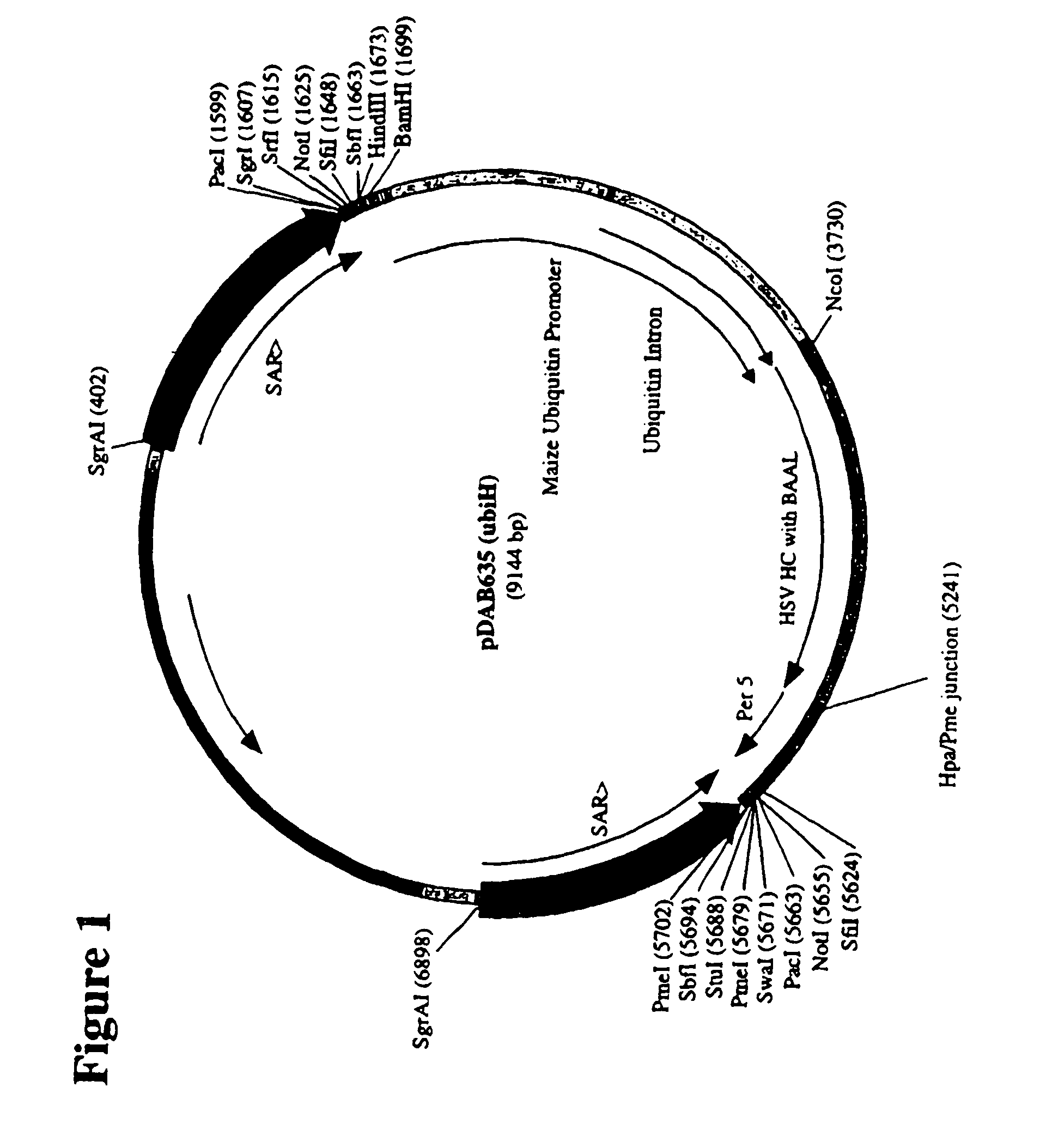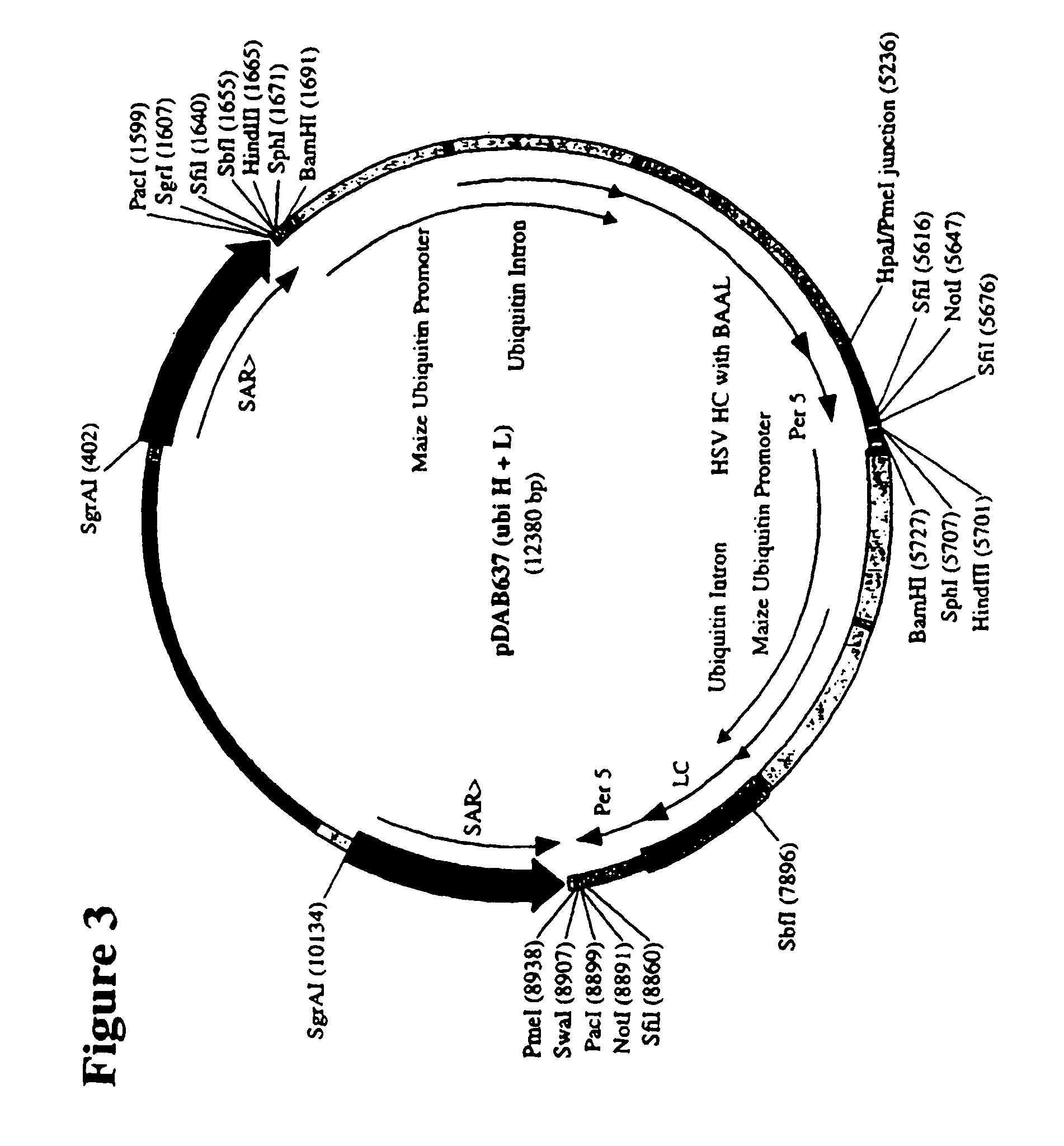Plant production of immunoglobulins with reduced fucosylation
- Summary
- Abstract
- Description
- Claims
- Application Information
AI Technical Summary
Benefits of technology
Problems solved by technology
Method used
Image
Examples
example 1
Construction of Ubiquitin / HC, LC Plasmids
[0372]Constitutive expression of anti-HSV antibody genes was chosen so as to enable the rapid analysis of protein production on callus tissue. More specifically, maize ubiquitin-1 promoter-driven HSV heavy chain HC and LC plasmid constructions and transgenic events were made to demonstrate correct assembly and accumulation of heavy chain and light chain genes from certain plasmid configurations.
[0373]Maize ubiquitin-1 (‘ubi’) is described, for example, in U.S. Pat. Nos. 5,510,474; 5,614,399; 6,020,190; and 6,054,574, each of which is herein incorporated in its entirety. MAR (matrix association region) is described in U.S. Pat. Nos. 5,773,689 and 6,239,328, each of which is herein incorporated in its entirety. Maize per5 UTR is described in U.S. Pat. No. 6,384,207, which is herein incorporated in its entirety. The genes used in this experiment were not rebuilt for plant codon-bias, and they contain the barley alpha-amylase leader sequence for ...
example 2
Alternative Methods of Delivering Multiple Plasmids
[0379]Because of the extreme differences in the size between the PAT plasmid (pDAB3014) and the antibody plasmids, there was concern that the use of equal mass amounts of DNA for co-transformation would result in inefficient delivery of each of the plasmids into the maize cells. In an effort to evaluate certain parameters for the delivery of multiple plasmids into maize cells, the use of molar equivalent amounts of DNA was compared to the use of mass equivalent amounts of DNA to determine if there is any effect on the efficiency at which the cells receive all of the necessary plasmids.
[0380]A total of 106 events were available for PCR and 10 events that were analyzed to be positive were regenerated.
[0381]Analysis of the transgenic callus events transformed with the ubiquitin / HC, LC plasmids was performed in two stages: 1) PCR identification of those events that contained intact genes of interest; and 2) Western and ELISA analysis of...
example 3
Vector Construction for Endosperm-Specific Anti-HSV Antibody Expression in Plants
[0388]The following examples involve a monomeric IgA antibody for control of the Herpes simplex Virus (HSV). The two genes coding for HC and LC were introduced into plants in one vector for seed-specific expression of monomeric antibodies with functionality against HSV.
[0389]The two antibody genes (HC and LC) were redesigned for optimal expression in plants using a method analogous to that taught in U.S. Pat. No. 5,380,831, which is herein incorporated in its entirety. Thus, the two human HSV antibody genes HC (SEQ ID NO: 1) and LC (SEQ ID NO: 9), as well as nucleotide sequences SEQ ID NOs: 3, 5, 7, 9, 11 and 13, have a codon-bias that most closely resembles plant codons than human codons for enhanced gene expression in maize.
[0390]Plasmid construction for the anti-HSV project required the assembly of four complex plasmids, each of which contain MAR sequences flanking two antibody plant transcription un...
PUM
| Property | Measurement | Unit |
|---|---|---|
| Fraction | aaaaa | aaaaa |
| Fraction | aaaaa | aaaaa |
| Fraction | aaaaa | aaaaa |
Abstract
Description
Claims
Application Information
 Login to View More
Login to View More - R&D
- Intellectual Property
- Life Sciences
- Materials
- Tech Scout
- Unparalleled Data Quality
- Higher Quality Content
- 60% Fewer Hallucinations
Browse by: Latest US Patents, China's latest patents, Technical Efficacy Thesaurus, Application Domain, Technology Topic, Popular Technical Reports.
© 2025 PatSnap. All rights reserved.Legal|Privacy policy|Modern Slavery Act Transparency Statement|Sitemap|About US| Contact US: help@patsnap.com



